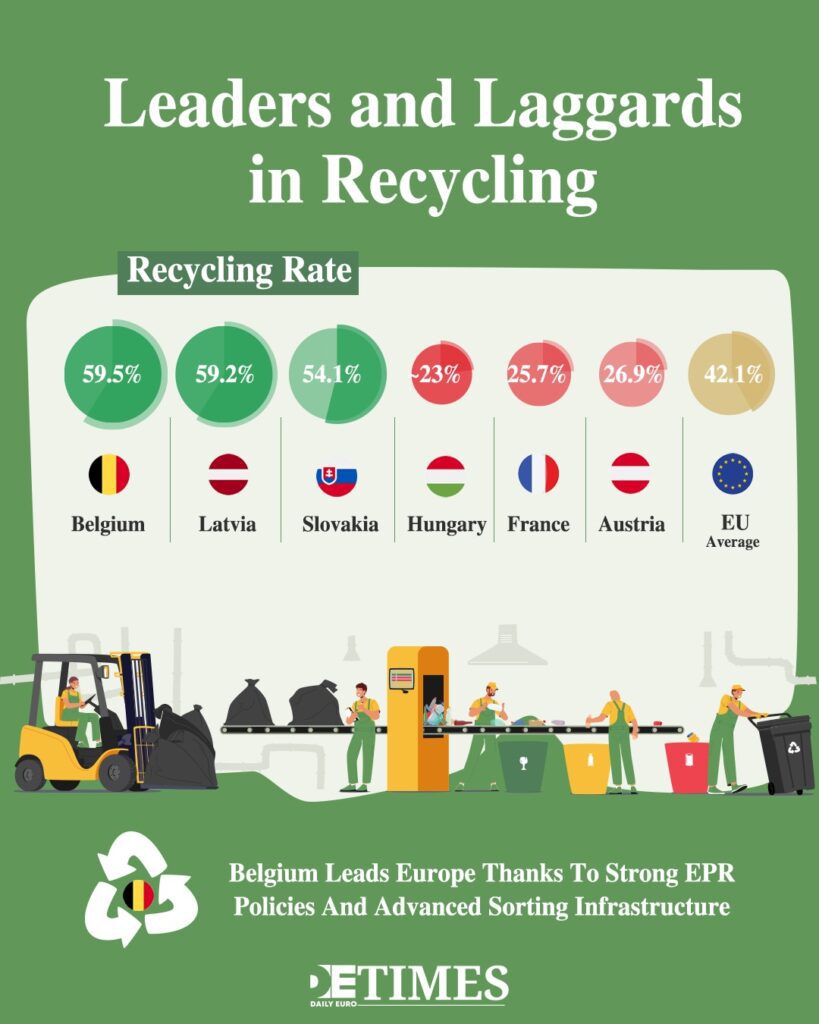The European Union is stepping up its efforts to reduce plastic pollution, and the figures confirm this in both alarming and encouraging ways.
According to Eurostat, in 2023, the average volume of plastic packaging waste in the EU per capita was 35.3 kg: a significant portion of the total packaging waste per capita, which reached 177.8 kg per year.
Meanwhile, the recycling rate of plastic packaging waste increased to 42.1% in 2023.
Why is this important? Plastic packaging is the fastest-growing waste stream in the consumer economy: the rise of online retail, single-use formats, and convenient on-the-go packaging have made it widespread and highly resistant to traditional recycling measures.
While recycling rates have improved, a new problem has emerged: microplastic particles, particularly plastic nurdles (pellets) — small granules used to produce plastic — regularly leach into the environment during transportation and recycling.
The EU has adopted a package of measures aimed at both reducing packaging waste and preventing such accidents.
Belgium: Who Recycles the Most?
Belgium leads the way in plastic packaging waste recycling, achieving a 59.5% recycling rate (2023).
It is followed by Latvia (59.2%) and Slovakia (54.1%). On the other hand, low rates are observed in Hungary (around 23%), France (25.7%), and Austria (26.9%). Even within the EU, the gap is more than twofold.
Belgium: Why?
Belgium has a well-developed waste separation system and a high density of specialised recycling facilities.
Second, cooperation between municipalities and the private sector and a well-designed system of financial incentives (Extended Producer Responsibility), under which producers contribute to the funding of packaging collection and recycling, play a significant role.
EPR models have proven effective in other countries, but in Belgium they operate in the most coordinated manner.
Comparison on the Continent
Many Scandinavian countries demonstrate high rates of overall waste management and material recycling, but specific recycling rates for plastic packaging can vary depending on accounting methodologies and local micro-fraction collection programs.
Western Europe (Germany, the Netherlands, Belgium) has high recycling rates due to a wide network of sorting facilities and developed deposit and EPR systems.
To the east, a number of countries are showing rapid growth in recycling rates, but absolute levels are still below the European average, reflecting a lack of infrastructure and funding in Slavic states.

What is the EU is Doing?
The problem of plastic pellets is not hypothetical: tens of tons of pellets are lost annually during loading, unloading, and maritime transport, ending up in soil and the sea, where they accumulate and cause long-term damage to ecosystems.
In 2025, the EU Council and the European Parliament agreed on a regulation aimed at preventing the loss of plastic pellets at all stages of the supply chain—from production to processing and transportation.
Measures include risk management requirements, improved packaging and transportation standards, and immediate cleanup obligations in the event of an incident. These measures are expected to reduce pellet losses by 54 –74% compared to baseline levels.
The regulation also requires monitoring and reporting for companies handling plastic pellets and imposes liability on transporters and manufacturers for spill prevention.
Experts note that this is the EU’s first systematic step against one of the smallest, yet most environmentally hazardous forms of plastic.
What Conclusions can be Drawn?
Progress has been made, but it is uneven. Increasing the recycling rate to 42.1% is a positive trend, but the gap between the leaders and the laggards remains large. A unified model for all EU countries does not yet exist.
Infrastructure and policies are crucial. Countries with developed separate collection systems, sorting centers, and EPR schemes achieve the best results.
Regulating microplastics is a new milestone. The pellet regulation aims to eliminate sources of micropollution that have been difficult to track and prevent until now.
If these measures prove effective, they will reduce long-term environmental and social risks.
Next Steps?
To achieve a sustainable transition, the EU needs a combination of strict regulation (as in the case of pellets), incentives for recycling and the implementation of EPR systems, as well as large-scale investment in sorting and recycling.
Furthermore, the role of the consumer is crucial: reducing the consumption of single-use packaging and moving toward recyclable solutions are key elements of a system where every contribution counts.
Read the Latest Articles on DET!
When the Angels Return: How Victoria’s Secret is Shocking the New Era of Beauty
From Sweden to Türkiye: The Stark Gender Divide in Unpaid Work
Social Capital Lives On: The Story of Germany and Russia





